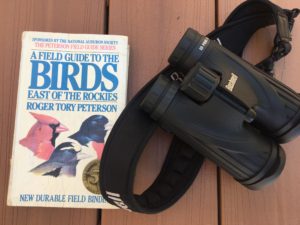Seven million of us have a copy. Mine sits on a table by the kitchen windows, next to the binoculars. I use it almost every morning. A Field Guide to the Birds, by Roger Tory Peterson. I’ve tried other bird guides, but I can’t break the habit to pick up Peterson’s book. Nor should I. Roger Tory Peterson is the man who made birdwatchers out of all of us.
Roger Tory Peterson was born on August 28, 1908, in Jamestown, New York (died 1996). He wasn’t like other children—they called him strange—and his parents had trouble understanding him. He was quiet, troublesome at school, often fell asleep in class. Then a teacher, Blanche Hornbeck, had her students all join the Junior Audubon Club; at age 11, Peterson had found his passion—birds.
He got a paper route so he could watch birds in the morning and earn money for a camera to photograph them. He became a good student, but mostly in art classes. As a teenager, he submitted paintings of birds to art shows—and won, often in competition with leading artists. He graduated high school when he was 16, and he followed his father into the furniture business. His skill as an artist was soon recognized and he was taken off the assembly line to paint the decorative designs on fancy furniture. His boss convinced him to go to art school, and he saved for two years to earn tuition. From 1927-1929, he studied art in New York, eventually at the National Academy of Design.
To earn a living, he became a teacher in the Boston area, but birds remained his passion—observing them, photographing them, painting them. He had an idea for a guide to birds that would be different than the complicated, taxonomically based bird guides of the time. Instead, he grouped birds by their appearance, making comparisons easier. He drew detailed pictures of birds, emphasizing their shapes, sizes, coloration, and individual features, like beaks, feet and tail shape. He placed arrows pointing to the distinctive features that observers should look for. He added simple, direct text about the birds’ ranges, flying patterns and songs. It was a guide for the amateur, not the specialist.
He submitted the book to four publishers, all of whom rejected it. He then sent it to Houghton-Mifflin, which decided to take a chance. Not much of one, however. They printed 2,000 copies and forced Peterson to forego royalties on the first 1,000 because the publisher needed to recover the cost of so many illustrations.
Surprise! The first 2,000 copies sold out in two weeks! It was a huge success, and gave birth to the modern hobby of bird watching. Over time, A Field Guide to the Birds went through 4 editions and 47 re-printings, and remains constantly in print to this day. In all, 7 million copies have been sold. Peterson didn’t stop there, however, going on to write, illustrate or edit more than 50 field guides for birds, flowers and other groups. Ecologist Paul Ehrlich credited Peterson as “the inventor of the modern field guide.”

His approach of clear, simple illustrations with arrows pointing out important features was a clear winner. When he was drafted into military service during World War II, he was assigned to create training manuals, and he adopted the same approach as in his bird guide. The Air Corps, for example, created a guide for identifying planes based on their appearance, complete with arrows to emphasize distinctive features.
Based on the success of his bird guides, Peterson became one of America’s leading conservationists. He worked for the Audubon Society for eight years as an educator and art director. Teasing apart his skill as a teacher, artist and naturalist is impossible, as they all combined in his work. He understood that animals, especially birds, could entice anyone to become a conservationist. He wrote:
“The philosophy that I have worked under most of my life is that the serious study of natural history is an activity which has far-reaching effects in every aspect of a person’s life. It ultimately makes people protective of the environment in a very committed way. It is my opinion that the study of natural history should be the primary avenue for creating environmentalists…”
Few would doubt the impact that that approach has had on our environment and the conservation movement. He is considered the father of American ornithology and received virtually every major conservation award that exists. When President Jimmy Carter bestowed on Peterson the Presidential Medal of Freedom on June 9, 1980, Carter said:
“Roger Tory Peterson has achieved distinction as a consummate painter, writer, teacher and scientist. As an unabashed lover of birds and a distinguished ornithologist, he has furthered the study, appreciation and protection of birds the world over. And he has done more. He has impassioned thousands of Americans, and has awakened in millions across this land, a fondness for nature’s other two-legged creatures.”
So, next time you scurry for the bird book so you can decide if you’re looking at a White-throated Sparrow or a White-Crowned one, give it up for the man who pointed out the way—Roger Tory Peterson.
References:
Houghton-Mifflin Books. Biography, Peterson Field Guides. Available at: http://www.houghtonmifflinbooks.com/peterson/rtp/biography.shtml. Accessed July 9, 2018.
Patuxent Wildlife Research Center. Roger Tory Peterson. Available at: https://www.pwrc.usgs.gov/resshow/perry/bios/PetersonRoger.htm. Accessed July 9, 2018.
Roger Tory Peterson Institute of Natural History. Biography. Available at: https://rtpi.org/roger-tory-peterson/roger-tory-peterson-biography/. Accessed July 9, 2018.
Severo, Richard. 1996. Roger Peterson, 87, The Nation’s Guide To the Birds, Is Dead. The New York Times, July 30, 1996. Available at: https://www.nytimes.com/1996/07/30/us/roger-peterson-87-the-nation-s-guide-to-the-birds-is-dead.html. Accessed July 9, 2018.
